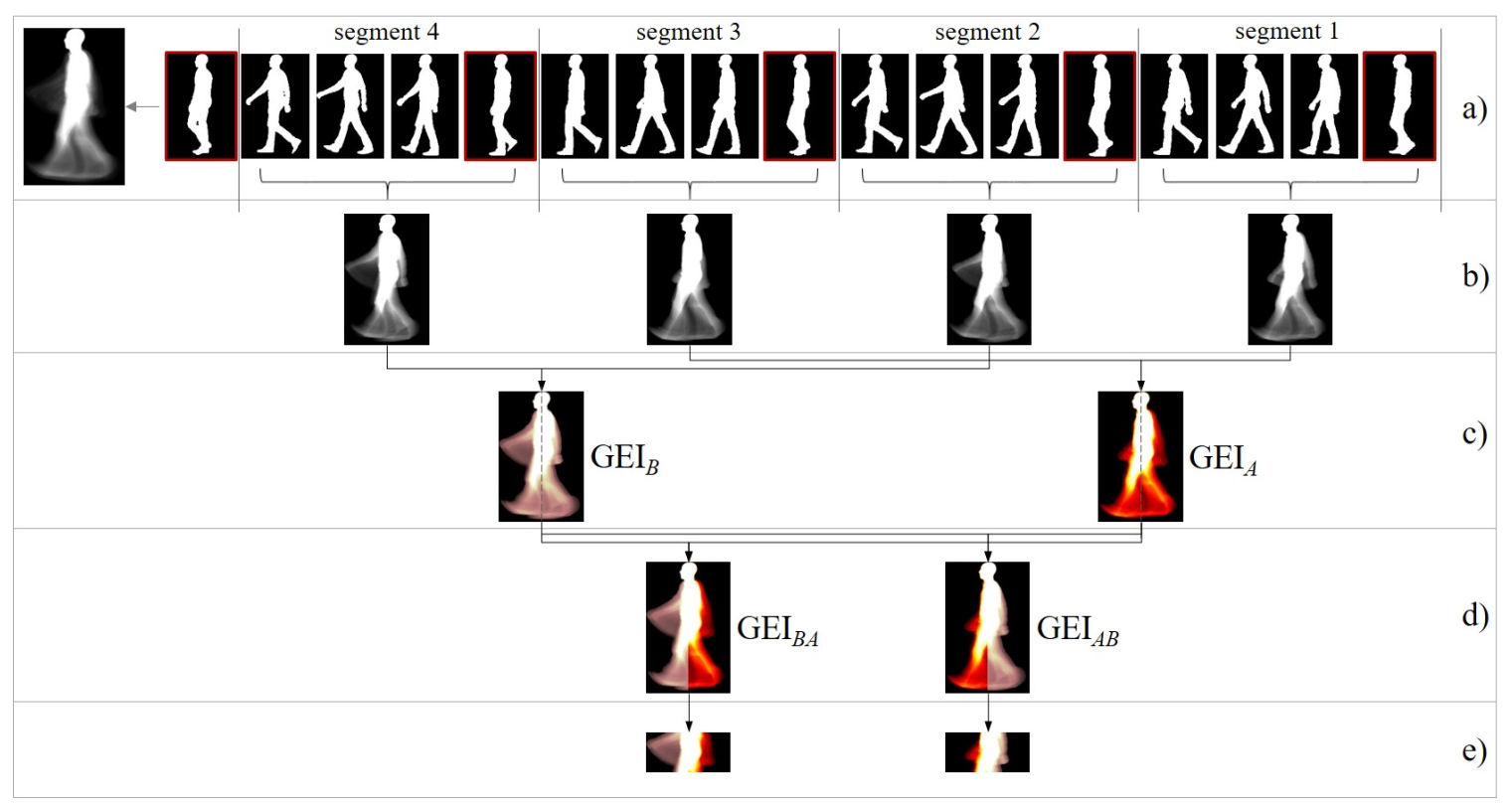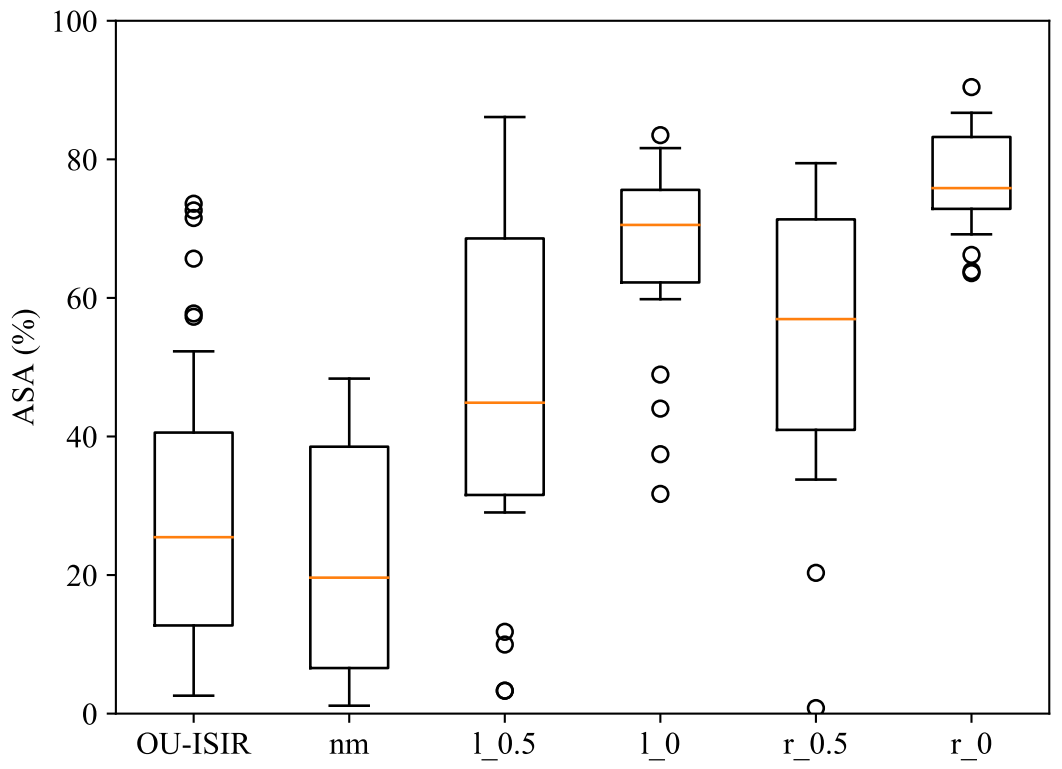Arm Swing Asymmetry Measurement from 2D Gait Videos
Abstract
1. Introduction
2. Materials and Methods
2.1. Datasets
- The left arm swings normally, while the right arm is volitionally held still.
- The right arm swings normally, while the left arm is volitionally held still.
- The left arm swings normally, while the right arm swing is incomplete.
- The right arm swings normally, while the left arm swing is incomplete.
2.2. Arm Swing Asymmetry Measurement
- Two side-based Gait Energy Images (GEI) [25] are built, so that each one comprises the motion data of each arm separately. A region of interest (ROI) containing arm motion is automatically extracted from each side-based representation.
- A Perceptible Motion Index (PMI) is introduced to quantify the amount of perceivable arm motion from each side-based ROI.
2.2.1. Side-Based Gait Energy Images
- White pixels.
- They capture body regions with zero or little relative motion with respect to image borders, e.g., head and torso. They encode appearance.
- Gray pixels.
- They capture most of the gait energy mainly caused by the cyclic movement of limbs. A gray value means that the pixel has sometimes been background (black in some gait frames) and sometimes silhouette (white in other frames). The more intermediate the gray value, the greater the balance between background and silhouette and, therefore, the greater the movement recorded.
- Black pixels.
- They capture background regions common to all silhouettes.
- A sequence of silhouettes is split into segments delimited by midstance/midswing poses (Figure 2a). Each resulting segment covers half a cycle.
- Segment-based GEIs are computed (Figure 2b). The way of splitting the sequence leads to segment-based GEIs in which each arm is captured either in the front side or in the back side (according to the coronal/frontal plane). This dynamic alternates along the segments: odd segments reflect an arm arrangement; the even ones, the opposite.
- Odd and even segment-based GEI are averaged separately (see Figure 2c). The two resulting GEIs are referred to as GEI and GEI, respectively. Due to the gait cyclic nature, the arm captured in the front side of GEI coincides with the one in the back side of GEI. Similarly, the motion in the back side of GEI and in the front side of GEI correspond to the other arm. Legs are also segregated.
- Two side-based GEIs are built by binding together the front side of GEI and the back side of GEI and, contrarily, the back of GEI and the front of GEI (Figure 2d). Let us denote the resulted side-based representations as GEI and GEI. Note that each of these representations condenses the movement of a single arm. For the purpose of estimating AS asymmetry, the correspondence between GEI/GEI and the left/right arms is irrelevant.
2.2.2. Perceptible Motion Index
2.2.3. Modified Robinson Index
3. Results
4. Discussion
5. Conclusions
Author Contributions
Funding
Data Availability Statement
Conflicts of Interest
Abbreviations
| AS | Arm Swing |
| PD | Parkinson’s Disease |
| GEI | Gait Energy Image |
| ROI | Region Of Interest |
| PMI | Perceptible Motion Index |
| ASA | Arm Swing Asymmetry |
References
- Bruijn, S.M.; Meijer, O.G.; Beek, P.J.; van Dieën, J.H. The effects of arm swing on human gait stability. J. Exp. Biol. 2010, 213, 3945–3952. [Google Scholar] [CrossRef] [PubMed]
- Umberger, B.R. Effects of suppressing arm swing on kinematics, kinetics, and energetics of human walking. J. Biomech. 2008, 41, 2575–2580. [Google Scholar] [CrossRef] [PubMed]
- Yizhar, Z.; Boulos, S.; Inbar, O.; Carmeli, E. The effect of restricted arm swing on energy expenditure in healthy men. Int. J. Rehabil. Res. 2009, 32, 115–123. [Google Scholar] [CrossRef] [PubMed]
- Kubo, M.; Ulrich, B. A biomechanical analysis of the high guard position of arms during walking in toddlers. Infant Behav. Dev. 2006, 29, 509–517. [Google Scholar] [CrossRef]
- Meyns, P.; Desloovere, K.; Van Gestel, L.; Massaad, F.; Smits-Engelsman, B.; Duysens, J. Altered arm posture in children with cerebral palsy is related to instability during walking. Eur. J. Pediatr. Neurol. 2012, 16, 528–535. [Google Scholar] [CrossRef]
- Lewek, M.D.; Poole, R.; Johnson, J.; Halawa, O.; Huang, X. Arm swing magnitude and asymmetry during gait in the early stages of Parkinson’s disease. Gait Posture 2010, 31, 256–260. [Google Scholar] [CrossRef]
- Huang, X.; Mahoney, J.M.; Lewis, M.M.; Du, G.; Piazza, S.J.; Cusumano, J.P. Both coordination and symmetry of arm swing are reduced in Parkinson’s disease. Gait Posture 2012, 35, 373–377. [Google Scholar] [CrossRef]
- Hejrati, B.; Chesebrough, S.; Foreman, K.B.; Abbott, J.J.; Merryweather, A.S. Comprehensive quantitative investigation of arm swing during walking at various speed and surface slope conditions. Hum. Mov. Sci. 2016, 49, 104–115. [Google Scholar] [CrossRef]
- Koh, S.B.; Park, Y.M.; Kim, M.J.; Kim, W.S. Influences of elbow, shoulder, trunk motion and temporospatial parameters on arm swing asymmetry of Parkinson’s disease during walking. Hum. Mov. Sci. 2019, 68, 102527. [Google Scholar] [CrossRef]
- Dietz, V. Quadrupedal coordination of bipedal gait: Implications for movement disorders. J. Neurol. 2011, 8, 1406. [Google Scholar] [CrossRef][Green Version]
- Meyns, P.; Bruijn, S.M.; Duysens, J. The how and why of arm swing during human walking. Gait Posture 2013, 4, 555–562. [Google Scholar] [CrossRef]
- Rubino, F.A. Gait disorders. Neurologist 2002, 8, 254–262. [Google Scholar] [CrossRef]
- Ospina, B.M.; Chaparro, J.A.V.; Paredes, J.D.A.; Pino, Y.J.C.; Navarro, A.; Orozco, J.L. Objective arm swing analysis in early-stage Parkinson’s disease using an RGB-D camera (Kinect). J. Park. Dis. 2018, 8, 563–570. [Google Scholar] [CrossRef]
- Kuhtz-Buschbeck, J.P.; Brockmann, K.; Gilster, R.; Koch, A.; Stolze, H. Asymmetry of arm-swing not related to handedness. Gait Posture 2008, 27, 447–454. [Google Scholar] [CrossRef]
- Killeen, T.; Elshehabi, M.; Filli, L.; Hobert, M.A.; Hansen, C.; Rieger, D.; Maetzler, W. Arm swing asymmetry in overground walking. Sci. Rep. 2018, 8, 12803. [Google Scholar] [CrossRef]
- Riad, J.; Coleman, S.; Lundh, D.; Broström, E. Arm posture score and arm movement during walking: A comprehensive assessment in spastic hemiplegic cerebral palsy. Gait Posture 2011, 33, 48–53. [Google Scholar] [CrossRef]
- Wochatz, M.; Tilgner, N.; Mueller, S.; Rabe, S.; Eichler, S.; John, M.; Völler, H.; Mayer, F. Reliability and validity of the Kinect V2 for the assessment of lower extremity rehabilitation exercises. Gait Posture 2019, 70, 330–335. [Google Scholar] [CrossRef]
- Fuertes-Muñoz, G.; Mollineda, R.A.; Gallardo-Casero, J.; Pla, F. A RGBD-Based Interactive System for Gaming-Driven Rehabilitation of Upper Limbs. Sensors 2019, 19, 3478. [Google Scholar] [CrossRef]
- Auvinet, E.; Multon, F.; Manning, V.; Meunier, J.; Cobb, J.P. A Validity and sensitivity of the longitudinal asymmetry index to detect gait asymmetry using Microsoft Kinect data. Gait Posture 2017, 51, 162–168. [Google Scholar] [CrossRef]
- Ortells, J.; Herrero-Ezquerro, M.T.; Mollineda, R.A. Vision-based gait impairment analysis for aided diagnosis. Med. Biol. Eng. Comput. 2018, 56, 1553–1564. [Google Scholar] [CrossRef]
- Verlekar, T.T.; Soares, L.D.; Correia, P.L. Automatic classification of gait impairments using a markerless 2D video-based system. Sensors 2018, 18, 2743. [Google Scholar] [CrossRef] [PubMed]
- Tan, D.; Pua, Y.H.; Balakrishnan, S.; Scully, A.; Bower, K.J.; Prakash, K.M.; Clark, R.A. Automated analysis of gait and modified timed up and go using the Microsoft Kinect in people with Parkinson’s disease: Associations with physical outcome measures. Med. Biol. Eng. Comput. 2019, 57, 369–377. [Google Scholar] [CrossRef] [PubMed]
- Eltoukhy, M.; Kuenze, C.; Oh, J.; Wooten, S.; Signorile, J. Kinect-based assessment of lower limb kinematics and dynamic postural control during the star excursion balance test. Gait Posture 2017, 58, 421–427. [Google Scholar] [CrossRef] [PubMed]
- Makihara, Y.; Mannami, H.; Tsuji, A.; Hossain, M.A.; Sugiura, K.; Mori, A.; Yagi, Y. The OU-ISIR gait database comprising the treadmill dataset. Trans. Comput. Vis. Appl. 2012, 4, 53–62. [Google Scholar] [CrossRef]
- Han, J.; Bhanu, B. Individual recognition using gait energy image. IEEE Trans. Pattern Anal. Mach. Intell. 2005, 28, 316–322. [Google Scholar] [CrossRef]
- LaRoche, D.P.; Cook, S.B.; Mackala, K. Strength asymmetry increases gait asymmetry and variability in older women. Med. Sci. Sport. Exerc. 2012, 44, 2172. [Google Scholar] [CrossRef]
- Viteckova, S.; Kutilek, P.; Svoboda, Z.; Krupicka, R.; Kauler, J.; Szabo, Z. Gait symmetry measures: A review of current and prospective methods. Biomed. Signal Process. Control 2018, 42, 89–100. [Google Scholar] [CrossRef]
- Mann, H.B.; Whitney, D.R. On a test of whether one of two random variables is stochastically larger than the other. Ann. Math. Stat. 1947, 18, 50–60. [Google Scholar] [CrossRef]
- Wilcoxon, F. Individual comparisons by ranking methods. Biom. Bull. 1945, 1, 80–83. [Google Scholar] [CrossRef]




| OU-ISIR | INIT Database | ||||
|---|---|---|---|---|---|
| 0.15/− | |||||
| 0.006/− | 0.006/0.047 | ||||
| /− | /0.005 | 0.006/0.012 | |||
| /− | /0.012 | 0.310/0.200 | − | ||
| /− | /0.005 | − | 0.013/0.012 | /0.009 | |
Publisher’s Note: MDPI stays neutral with regard to jurisdictional claims in published maps and institutional affiliations. |
© 2021 by the authors. Licensee MDPI, Basel, Switzerland. This article is an open access article distributed under the terms and conditions of the Creative Commons Attribution (CC BY) license (https://creativecommons.org/licenses/by/4.0/).
Share and Cite
Mollineda, R.A.; Chía, D.; Fernandez-Beltran, R.; Ortells, J. Arm Swing Asymmetry Measurement from 2D Gait Videos. Electronics 2021, 10, 2602. https://doi.org/10.3390/electronics10212602
Mollineda RA, Chía D, Fernandez-Beltran R, Ortells J. Arm Swing Asymmetry Measurement from 2D Gait Videos. Electronics. 2021; 10(21):2602. https://doi.org/10.3390/electronics10212602
Chicago/Turabian StyleMollineda, Ramón A., Daniel Chía, Ruben Fernandez-Beltran, and Javier Ortells. 2021. "Arm Swing Asymmetry Measurement from 2D Gait Videos" Electronics 10, no. 21: 2602. https://doi.org/10.3390/electronics10212602
APA StyleMollineda, R. A., Chía, D., Fernandez-Beltran, R., & Ortells, J. (2021). Arm Swing Asymmetry Measurement from 2D Gait Videos. Electronics, 10(21), 2602. https://doi.org/10.3390/electronics10212602







